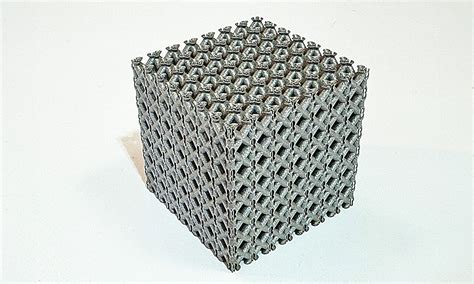3D Printed Titanium: Design and Print Complex Geometries
Titanium's exceptional properties – high strength-to-weight ratio, excellent corrosion resistance, and biocompatibility – make it a highly sought-after material in aerospace, medical implants, and automotive industries. However, traditional manufacturing methods struggle to create complex titanium components efficiently and cost-effectively. 3D printing, or additive manufacturing, offers a revolutionary solution, enabling the creation of intricate geometries previously impossible to achieve. This article delves into the exciting world of 3D printed titanium, exploring its design considerations and the processes involved in printing these complex structures.
Understanding the Advantages of 3D Printed Titanium
Before diving into the specifics of design and printing, let's highlight why 3D printing titanium is transforming various sectors:
- Complex Geometries: 3D printing allows for the creation of intricate internal channels, lattice structures, and highly customized shapes that would be impossible or prohibitively expensive to manufacture using traditional subtractive methods like machining.
- Lightweight Designs: By utilizing lattice structures and optimizing designs for additive manufacturing, engineers can significantly reduce the weight of components without compromising strength. This is particularly crucial in aerospace applications.
- Reduced Material Waste: Additive manufacturing uses only the necessary material, minimizing waste compared to traditional methods that often involve significant material removal.
- Consolidation of Parts: Multiple components can be integrated into a single 3D printed part, simplifying assembly and reducing manufacturing costs.
- Customization and Personalization: 3D printing enables the creation of highly customized parts tailored to specific needs, especially vital in the medical field for implants and prosthetics.
Design Considerations for 3D Printed Titanium
Designing for 3D printing titanium differs significantly from traditional design approaches. Several critical factors must be considered:
Support Structures:
- Overhangs and Undercuts: Titanium's high melting point and the nature of the 3D printing processes necessitate the use of support structures to prevent sagging or deformation during printing. Designers need to carefully plan these supports to ensure they can be easily removed without damaging the final part.
- Support Material Removal: The choice of support material and the ease of its removal is crucial. The support structures must be easily separable from the main part without leaving behind residues or compromising the integrity of the finished component.
Orientation and Build Direction:
- Optimal Layer Orientation: The orientation of the part during printing significantly impacts the mechanical properties of the final product. Careful consideration is needed to minimize stress concentrations and maximize strength in critical areas.
- Part Strength and Stability: The build direction should be chosen to maximize strength and minimize the risk of warping or distortion during the printing process.
Topology Optimization:
- Lightweighting and Strength: Topology optimization software allows designers to create lightweight yet strong parts by removing material from non-critical areas while maintaining structural integrity. This is particularly beneficial for titanium, where weight reduction is a significant advantage.
- Enhanced Performance: Topology optimization leads to improved performance and efficiency of the final product.
3D Printing Processes for Titanium
Several additive manufacturing processes are used to print titanium components, each with its strengths and weaknesses:
Electron Beam Melting (EBM):
- Vacuum Environment: EBM uses a high-powered electron beam to melt and fuse titanium powder layer by layer in a vacuum chamber. This prevents oxidation and ensures high-quality parts.
- High Density and Strength: EBM consistently produces parts with high density and excellent mechanical properties.
Selective Laser Melting (SLM):
- Laser-Based Process: SLM utilizes a high-powered laser to melt and fuse titanium powder, building the part layer by layer.
- High Precision and Detail: SLM offers high precision and the capability to create intricate geometries.
Arc Melting:
- Consolidation of Material: Arc melting methods are used to consolidate titanium powder into larger ingots before fabrication.
- Preparation for other processes: The resulting ingots can be machined or used as input material for other additive manufacturing techniques.
Addressing Common Questions
What are the limitations of 3D printed titanium?
While 3D printed titanium offers numerous advantages, there are limitations. The high cost of the equipment and materials remains a significant barrier. The process can also be relatively slow compared to traditional manufacturing methods, and post-processing steps, such as heat treatment, may be necessary to achieve optimal mechanical properties.
How is the surface finish of 3D printed titanium?
The surface finish of 3D printed titanium is typically rougher than that of traditionally manufactured parts. Post-processing techniques, such as machining or polishing, are often required to achieve a smoother surface finish.
What types of applications benefit most from 3D printed titanium?
Applications that benefit significantly include aerospace components (lightweight, high-strength parts), medical implants (customized designs, biocompatibility), and high-performance automotive parts (reduced weight, improved performance).
Conclusion
3D printing is revolutionizing the use of titanium, enabling the creation of complex geometries and lightweight designs that were previously impossible to achieve. By carefully considering design parameters and selecting the appropriate printing process, engineers can unlock the full potential of this remarkable material, pushing the boundaries of innovation across various industries. As the technology continues to advance, the applications of 3D printed titanium are only limited by our imagination.

